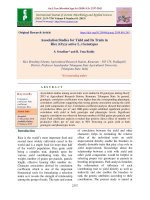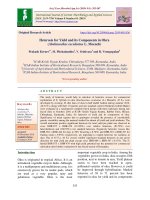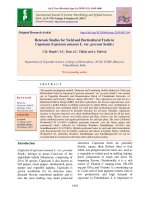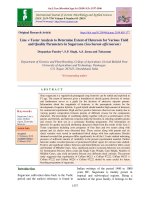Combining ability for yield and quality traits in early generation inbred lines of okra
Bạn đang xem bản rút gọn của tài liệu. Xem và tải ngay bản đầy đủ của tài liệu tại đây (380.37 KB, 10 trang )
Int.J.Curr.Microbiol.App.Sci (2018) 7(7): 1879-1888
International Journal of Current Microbiology and Applied Sciences
ISSN: 2319-7706 Volume 7 Number 07 (2018)
Journal homepage:
Original Research Article
/>
Combining Ability for Yield and Quality Traits in Early Generation
Inbred Lines of Okra
V. Harshavardhan Gowda, Shantappa Tirakannanavar*, R.C. Jagadeesha,
V.D. Gasti, S.M. Veeresha and Ashok
Department of Biotechnology and Crop Improvement, University of Horticultural Sciences
Bagalkot, Karnataka, India
*Corresponding author
ABSTRACT
Keywords
Combining ability,
Line x tester
analysis, Yield and
quality parameters,
okra
Article Info
Accepted:
15 June 2018
Available Online:
10 July 2018
An experiment was conducted at Department of Biotechnology and Crop
Improvement, Kittur Rani Channamma College of Horticulture, Arabhavi
during the year 2013-14. Ninety-four hybrids derived by crossing fortyseven lines with two testers were evaluated along with parents and
commercial check in Latin square design. Data was been subjected to line x
tester analysis. Variance due to crosses was significant for all the yield and
quality parameters studied. The maximum and significant gca effects in
desirable direction was observed in the Line-44 for total fruit yield per
plant, Line-7 for average fruit weight, Line-46 for number of fruits per
plant, Line-14 for fruit length, Line-14 for fruit diameter. The crosses Line24 x Arka Anamika (201.496) followed by Line -23 X IC550848 (176.180)
were identified as good specific combiners for total fruit yield. The present
investigation reveals that the parents can be used to exploit heterosis.
Introduction
Okra [Abelmoschus esculentus (L.) Moench]
is a fast growing annual is commonly known
as bhendi or lady’s finger in India. India is the
largest producer of okra in the world with an
annual production of 63.46 million tonnes
from an area of 0.532 million hectares with a
productivity of 11.9 tonnes per hectare
(Anon., 2014). It occupies fifth position, in
area among the vegetables grown in India and
is a tremendous export potential as fresh
vegetable, which accounts for 60 per cent of
the fresh vegetables exported from India
(Jasol, 1989).
Although India is the leading country in okra
production, but the productivity is very low
due to poor yielding varieties, hence there is a
scope for hybrids. The concept of combining
1879
Int.J.Curr.Microbiol.App.Sci (2018) 7(7): 1879-1888
ability is landmark in the hybridization
programme. Combining ability analysis is one
of the effective approaches available for
estimating the combining ability effects that
helps in selecting desirable parents and crosses
for the exploitation of heterosis. In order to
identify potential cross combinations, it is
very important to screen out the parent
materials for genetic diversity and combining
ability (Kumar and Kumar, 2015). Line x
Tester method is considered one of the
effective ways for estimating the general and
specific combining ability to select the inbred
lines for further generation (Kempthorne,
1957). The present investigation was carried
out to evaluate early generation inbred lines
for combining ability.
Materials and Methods
The investigation on evaluation of early
generation inbred lines and hybrid seed
production in okra was undertaken during the
year 2013-2014 in Kharif season. The
experimental material comprised of 47 early
generation inbred lines which were selected
based on their per se performance for yield
and quality attributes, 2 testers and their 94 F1
hybrids along with one commercial check.
Each of the 47 lines was crossed with each of
the two testers (Arka Anamika and IC550848)
to derive 94 F1 hybrids following Line x
Tester method (Kempthorne, 1957).
These 94 hybrids along with 49 parents and
one commercial check were sown at spacing
of 60 x 30 cm apart. Observations were
recorded on the tagged five plants chosen at
random in each genotype and in each
replication. The mean of five plants was taken
for analysis. Combining ability analysis was
carried out according to the formulae given by
Kempthorne (1957) through computergenerated program, WINDOSTAT (edition
9.1)
Results and Discussion
The analysis of variance showed significant
variation among the crosses and line x tester
for all seven characters, indicating the
variation among the crosses may be due to
positive interaction between male and female
for expression of characters, further it reveals
the possibility of non additive gene action, this
can be exploited by recurrent selection or
heterotic breeding (Table 1). However the
mean sum of squares among lines and testers
where non-significant, but lines and tester
have interacted in a positive way to create
variability in the cross combinations. The nonsignificant variation in lines indicates that they
may have derived from same gene pool; these
results are confirmatory with Laxman et al.,
(2013) and Khatik et al., (2012).
Critical evaluation of the results with respect
to specific combining ability effects, out of 94
crosses, five crosses have shown high sca for
the yield parameters. Crosses Line-3 x AA (L
x L), Line-12 x AA (L x L), Line-26 x IC (A x
H), Line-31 x IC (H x H) and Line-33 x IC (H
x H) have high sca for over all yield
parameters (Table 3). Indicating significant
sca may be due to the involving the parents H
x H, L x H, L x H, A x H and L x L. The sca
involving H x H combination could be used in
developing of the varieties to exploit additive
gene action by pedigree. Whereas, the crosses
involving the combination of L x L could be
used for exploitation of heterosis by recurrent
selection (Table 3). For yield parameters
combining ability was reported by Nagesh et
al., (2014), Hazem et al., (2013) and Ashwani
et al., (2013). Crosses Line-6 x IC (H x H),
Line-10 x IC (H x H), Line-20 x AA (L x L),
Line- 24 x IC (A x H) and Line-45 x IC (A x
H) have high sca for over all fruit quality. It
indicates significant sca may be due to the
involving of the parents H x H, L x H, L x H
and L x L.
1880
Int.J.Curr.Microbiol.App.Sci (2018) 7(7): 1879-1888
Table.1 Analysis of variance (mean sum of squares) of line x tester analysis for various characters in okra
Character
Degree of freedom
Number of fruits
Average fruit weight (g)
Total fruit yield per plant
(g)
Fruit length (cm)
Fruit diameter (mm)
No. of ridges on fruit
No. of locules per fruit
Replication
1
0.211
0.562
717.860
Crosses
93
24.690 **
22.719 **
28792.16 **
Lines
46
28.578
13.823
25063.01
Tester
1
26.138
779.943 **
646092.5 **
Line * Tester
46
20.770 **
15.153 **
19101.75 **
Error
93
0.417
0.635
663.556
Total
187
12.488
11.617
14652.94
2.960 *
1.577
0.005
0.005
7.518 **
6.586 **
4.120 **
3.899 **
7.365
6.324
2.629
2.443
9.165
8.924
121.282 **
118.090 **
7.635 **
6.796 **
3.065 **
2.873 **
0.463
1.029
0.005
0.005
3.985
3.795
2.052
1.942
1881
Int.J.Curr.Microbiol.App.Sci (2018) 7(7): 1879-1888
Table.2 General combining ability effects for growth parameters in okra
Parents
Lines
Line-1
Line-2
Line-3
Line-4
Line-5
Line-6
Line-7
Line-8
Line-9
Line-10
Line-11
Line-12
Line-13
Line-14
Line-15
Line-16
Line-17
Line-18
Line-19
Line-20
Line-21
Line-22
Line-23
Line-24
Line-25
Number of fruits
per plant
-3.895 **
-1.095 **
-2.520 **
-2.670 **
-1.170 **
-2.520 **
-1.645 **
-5.145 **
-2.945 **
-2.520 **
-1.970 **
-1.045 *
-2.320 **
-2.470 **
-1.120 **
-3.895 **
1.955 **
1.655 **
-1.670 **
-3.395 **
1.230 **
6.405 **
3.030 **
6.455 **
-2.845 **
Average fruit
weight (g)
-2.056 **
-0.766
-1.139 **
0.811 *
-2.319 **
1.501 **
3.558 **
-3.441 **
-3.319 **
-1.079 **
1.379 **
-1.326 **
0.016
1.829 **
-1.079 **
-0.184
2.541 **
1.694 **
-1.431 **
-1.421 **
-1.379 **
1.206 **
-1.216 **
-3.081 **
-1.784 **
Total fruit yield per
plant (g)
-113.326 **
-41.226 **
-68.476 **
-28.726 *
-87.701 **
-7.551
60.674 **
-158.676 **
-126.726 **
-73.001 **
1.874
-52.751 **
-40.401 **
5.349
-44.376 **
-69.701 **
96.349 **
81.774 **
-65.001 **
-89.051 **
-15.426
153.550 **
41.424 **
10.249
-91.651 **
1882
Fruit length
(cm)
1.718 **
-2.840 **
0.493
1.460 **
1.655 **
0.790 *
0.968 **
-0.607
1.018 **
0.218
-3.258 **
-0.357
2.155 **
2.543 **
-0.745 *
-0.22
2.293 **
1.805 **
-1.433 **
-2.008 **
0.167
0.192
-1.058 **
-0.195
-0.088
Fruit diameter
(mm)
-0.337
-1.127 *
1.475 **
-0.542
-1.832 **
2.215 **
2.425 **
-0.897
-0.952
0.515
1.328 *
0.093
1.315 *
3.105 **
-1.862 **
0.063
1.723 **
0.318
-1.967 **
-1.650 **
-0.097
1.813 **
0.848
0.958
-0.612
No. of
ridges
-0.867 **
-0.367 **
0.133 *
0.133 *
-0.867 **
0.633 **
0.633 **
-0.867 **
-0.867 **
1.133 **
-0.867 **
0.133 *
0.133 *
0.633 **
-0.867 **
0.133 *
0.133 *
-0.867 **
-0.367 **
-0.867 **
-0.867 **
-0.867 **
-0.867 **
1.133 **
-0.867 **
No. of
locules
-0.856 **
-0.356 **
0.144 **
1.144 **
-0.856 **
1.144 **
1.144 **
-0.856 **
-0.356 **
1.144 **
-0.856 **
-0.356 **
0.644 **
0.144 **
-0.856 **
0.144 **
0.144 **
-0.856 **
-0.356 **
-0.856 **
-0.856 **
-0.856 **
-0.856 **
1.144 **
-0.856 **
Int.J.Curr.Microbiol.App.Sci (2018) 7(7): 1879-1888
Line-26
Line-27
Line-28
Line-29
Line-30
Line-31
Line-32
Line-33
Line-34
Line-35
Line-36
Line-37
Line-38
Line-39
Line-40
Line-41
Line-42
Line-43
Line-44
Line-45
Line-46
Line-47
CD @ 5%
Tester
AA
IC
CD @ 5%
2.330 **
-1.895 **
-1.670 **
-4.695 **
1.155 **
1.230 **
1.105 **
3.905 **
1.655 **
2.380 **
1.105 **
1.780 **
-0.22
7.605 **
-3.120 **
-0.795
-0.970 *
-0.22
5.305 **
0.43
10.705 **
-0.970 *
0.807
-2.366 **
0.436
2.644 **
0.219
-3.269 **
3.221 **
-0.544
0.221
0.428
-2.516 **
0.311
0.459
0.351
2.434 **
2.031 **
0.259
1.986 **
0.036
3.204 **
1.471 **
0.603
0.864 *
0.807
-11.301
-28.201 *
41.749 **
-73.601 **
-64.101 **
116.025 **
2.074
81.149 **
35.024 *
-26.176
25.699
38.074 **
-1.501
183.250 **
-6.926
-9.826
31.024 *
-3.951
188.450 **
37.649 **
169.775 **
-1.851
26.768
1.673 **
0.143
-0.508
-3.383 **
-0.712
-0.508
-0.143
1.493 **
-0.732 *
-1.308 **
-0.157
-0.608
-0.352
1.098 **
-0.332
-0.133
0.047
-0.857 *
-1.590 **
0.293
0.47
1.443 **
0.724
-0.897
1.690 **
-0.325
-0.647
0.048
-1.415 *
-0.072
0.893
0.808
-0.82
0.023
-1.497 **
-1.875 **
0.01
-0.54
-0.857
0.84
-1.395 *
-0.477
0.073
1.323 *
-1.197 *
1.089
-0.367 **
0.633 **
-0.867 **
1.133 **
-0.867 **
0.133 *
0.133 *
0.633 **
-0.367 **
-0.867 **
1.133 **
1.133 **
0.133 *
0.133 *
-0.867 **
0.633 **
-0.117
1.633 **
1.633 **
1.133 **
1.133 **
-0.867 **
0.132
0.144 **
0.644 **
-0.856 **
1.144 **
-0.856 **
0.144 **
0.394 **
0.644 **
-0.356 **
-0.856 **
-0.356 **
1.144 **
-0.356 **
0.144 **
-0.856 **
0.644 **
0.144 **
1.144 **
1.144 **
1.144 **
0.644 **
-0.856 **
0.059
-0.249
0.249
0.167
-2.303
2.303
0.166
-58.623 **
58.623 **
5.522
-0.221 **
0.221 **
0.149
-0.218
0.218
0.225
-0.803 **
0.803 **
0.027
-0.793 **
0.793 **
0.012
* Significant at 5 %; ** Significant at 1%; AA- Arka Anamika,;
IC- IC550848
1883
Int.J.Curr.Microbiol.App.Sci (2018) 7(7): 1879-1888
Table.3 Specific combining ability effects for earliness, yield, fruit quality and seed quality parameters in okra
Crosses
Number of fruits
Average fruit
Total fruit yield per
Fruit length
Fruit diameter
No. of
No. of
per plant
weight (g)
plant (g)
(cm)
(mm)
ridges
locules
Line-1 x AA
1.048 *
-0.956
1.239
-1.129 *
-0.397
0.803 **
0.793 **
Line-1 x IC
-1.048 *
0.956
-1.239
1.129 *
0.397
-0.803 **
-0.793 **
Line-2 x AA
-3.152 **
2.774 **
22.066
0.543
-1.407
0.303 **
0.293 **
Line-2 x IC
3.152 **
-2.774 **
-22.066
-0.543
1.407
-0.303 **
-0.293 **
Line-3 x AA
1.473 **
3.087 **
100.06 **
-2.254 **
0.99
-0.197 *
-0.207 **
Line-3 x IC
-1.473 **
-3.087
-100.06 **
2.254 **
-0.99
0.197 *
0.207 **
Line-4 x AA
1.573 **
-0.198
26.845
1.513 **
1.383
-0.197 *
-1.207 **
Line-4 x IC
-1.573 **
0.198
-26.845
-1.513 **
-1.383
0.197 *
1.207 **
Line-5 x AA
3.123 **
-1.318 *
13.071
-0.442
-0.222
0.803 **
0.793 **
Line-5 x IC
-3.123 **
1.318 *
-13.071
0.442
0.222
-0.803 **
-0.793 **
Line-6 x AA
0.423
-3.158 **
-63.691 **
-1.352 *
-2.410 **
-0.697 **
-1.207 **
Line-6 x IC
-0.423
3.158 **
63.691 **
1.352 *
2.410 **
0.697 **
1.207 **
Line-7 x AA
-0.402
0.099
-4.143
-1.729 **
-1.07
-0.697 **
-1.207 **
Line-7 x IC
0.402
-0.099
4.143
1.729 **
1.07
0.697 **
1.207 **
Line-8 x AA
0.448
-1.351 *
-12.273
0.896
-0.227
0.803 **
0.793 **
Line-8 x IC
-0.448
1.351 *
12.273
-0.896
0.227
-0.803 **
-0.793 **
Line-9 x AA
-0.202
1.052
27.705
-0.429
-1.132
0.803 **
0.293 **
Line-9 x IC
0.202
-1.052
-27.705
0.429
1.132
-0.803 **
-0.293 **
Line-10 x AA
1.473 **
-2.638 **
-35.254
-2.229 **
-2.565 **
-1.197 **
-1.207 **
Line-10 x IC
-1.473 **
2.638 **
35.254
2.229 **
2.565 **
1.197 **
1.207 **
Line-11 x AA
-2.127 **
1.194 *
-6.718
0.246
1.393
0.803 **
0.793 **
Line-11 x IC
2.127 **
-1.194 *
6.718
-0.246
-1.393
-0.803 **
-0.793 **
1884
Int.J.Curr.Microbiol.App.Sci (2018) 7(7): 1879-1888
Line-12 x AA
1.948 **
1.289 *
63.669 **
1.946 **
0.193
-0.197 *
0.293 **
Line-12 x IC
-1.948 **
-1.289 *
-63.669 **
-1.946 **
-0.193
0.197 *
-0.293 **
Line-13 x AA
1.523 **
0.692
45.351 *
-0.392
-1.865 *
-0.197 *
-0.707 **
Line-13 x IC
-1.523 **
-0.692
-45.351 *
0.392
1.865 *
0.197 *
0.707 **
Line-14 x AA
-1.327 *
-0.006
-21.073
-1.554 **
-0.175
-0.697 **
-0.207 **
Line-14 x IC
1.327 *
0.006
21.073
1.554 **
0.175
0.697 **
0.207 **
Line-15 x AA
-0.977
0.062
-11.677
1.278 *
1.208
0.803 **
0.793 **
Line-15 x IC
0.977
-0.062
11.677
-1.278 *
-1.208
-0.803 **
-0.793 **
Line-16 x AA
-0.052
2.267 **
57.261 **
0.038
1.873 *
-0.197 *
-0.207 **
Line-16 x IC
0.052
-2.267 **
-57.261 **
-0.038
-1.873 *
0.197 *
0.207 **
Line-17 x AA
-2.902 **
3.942 **
50.504 **
-1.054 *
3.143 **
-0.197 *
-0.207 **
Line-17 x IC
2.902 **
-3.942 **
-50.504 **
1.054 *
-3.143 **
0.197 *
0.207 **
Line-18 x AA
-1.402 **
-2.766
107.632 **
2.783 **
-1.402
0.803 **
0.793 **
Line-18 x IC
1.402 **
2.766 **
107.632 **
-2.783 **
1.402
-0.803 **
-0.793 **
Line-19 x AA
1.173 *
0.714
38.376 *
1.171 *
-0.337
0.303 **
0.293 **
Line-19 x IC
-1.173 *
-0.714
-38.376 *
-1.171 *
0.337
-0.303 **
-0.293 **
Line-20 x AA
0.048
0.229
12.416
2.946 **
1.965 *
0.803 **
0.793 **
Line-20 x IC
-0.048
-0.229
-12.416
-2.946 **
-1.965 *
-0.803 **
-0.793 **
Line-21 x AA
-2.577 **
0.712
-21.926
0.721
-0.477
0.803 **
0.793 **
Line-21 x IC
2.577 **
-0.712
21.926
-0.721
0.477
-0.803 **
-0.793 **
Line-22 x AA
-3.952 **
0.347
-99.409 **
-1.154 *
-0.747
0.803 **
0.793 **
Line-22 x IC
3.952 **
-0.347
99.409 **
1.154 *
0.747
-0.803 **
-0.793 **
Line-23 x AA
-4.777 **
-3.121
-176.180 **
0.396
-2.367 **
0.803 **
0.793 **
Line-23 x IC
4.777 **
3.121 **
176.180 **
-0.396
2.367 **
-0.803 **
-0.793 **
Line-24 x AA
5.773 **
2.709 **
201.496 **
-1.092 *
-1.342
-1.197 **
-1.207 **
1885
Int.J.Curr.Microbiol.App.Sci (2018) 7(7): 1879-1888
Line-24 x IC
-5.773 **
-2.709
-201.496 **
1.092 *
1.342
1.197 **
1.207 **
Line-25 x AA
-1.702 **
3.107 **
53.757 **
0.816
1.488
0.803 **
0.793 **
Line-25 x IC
1.702 **
-3.107 **
-53.757 **
-0.816
-1.488
-0.803 **
-0.793 **
Line-26 x AA
-3.577 **
-1.826 **
-122.264 **
-1.074 *
-1.137
0.303 **
-0.207 **
Line-26 x IC
3.577 **
1.826 **
122.264 **
1.074 *
1.137
-0.303 **
0.207 **
Line-27 x AA
2.798 **
-0.723
31.744
1.146 *
1.990 *
-0.697 **
-0.707 **
Line-27 x IC
-2.798 **
0.723
-31.744
-1.146 *
-1.990 *
0.697 **
0.707 **
Line-28 x AA
-0.977
-1.781 **
-61.116 **
1.296 *
-0.465
0.803 **
0.793 **
Line-28 x IC
0.977
1.781 **
61.116 **
-1.296 *
0.465
-0.803 **
-0.793 **
Line-29 x AA
0.548
3.609 **
95.706 **
0.721
0.303
-1.197 **
-1.207 **
Line-29 x IC
-0.548
-3.609 **
-95.706 **
-0.721
-0.303
1.197 **
1.207 **
Line-30 x AA
-2.452 **
-0.108
-47.514 *
-0.849
0.418
0.803 **
0.793 **
Line-30 x IC
2.452 **
0.108
47.514 *
0.849
-0.418
-0.803 **
-0.793 **
Line-31 x AA
-1.577 **
-2.388 **
-101.264 **
-0.754
-0.37
-0.197 *
-0.207 **
Line-31 x IC
1.577 **
2.388 **
101.264 **
0.754
0.37
0.197 *
0.207 **
Line-32 x AA
-1.552 **
1.922 **
24.868
0.761
1.928 *
-0.197 *
-0.457 **
Line-32 x IC
1.552 **
-1.922 **
-24.868
-0.761
-1.928 *
0.197 *
0.457 **
Line-33 x AA
-2.002 **
-1.318 *
-99.403 **
0.096
1.853 *
2.303 **
2.293 **
Line-33 x IC
2.002 **
1.318 *
99.403 **
-0.096
-1.853 *
-2.303 **
-2.293 **
Line-34 x AA
1.048 *
-1.682 **
-33.561
1.871 **
0.008
0.303 **
0.293 **
Line-34 x IC
-1.048 *
1.682 **
33.561
-1.871 **
-0.008
-0.303 **
-0.293 **
Line-35 x AA
-3.277 **
0.349
-55.314 **
3.046 **
-0.885
0.803 **
0.793 **
Line-35 x IC
3.277 **
-0.349
55.314 **
-3.046 **
0.885
-0.803 **
-0.793 **
Line-36 x AA
-0.952
0.672
-1.803
-1.504 **
-1.207
-1.197 **
0.293 **
Line-36 x IC
0.952
-0.672
1.803
1.504 **
1.207
1.197 **
-0.293 **
1886
Int.J.Curr.Microbiol.App.Sci (2018) 7(7): 1879-1888
Line-37 x AA
1.273 *
-1.176 *
-16.033
-1.454 **
0.253
-1.197 **
-1.207 **
Line-37 x IC
-1.273 *
1.176 *
16.033
1.454 **
-0.253
1.197 **
1.207 **
Line-38 x AA
3.173 **
0.092
54.895 **
-0.359
0.93
-0.197 *
0.293 **
Line-38 x IC
-3.173 **
-0.092
-54.895 **
0.359
-0.93
0.197 *
-0.293 **
Line-39 x AA
4.198 **
-0.851
113.151 **
-1.949 **
1.05
-0.197 *
-0.207 **
Line-39 x IC
-4.198 **
0.851
-113.151 **
1.949 **
-1.05
0.197 *
0.207 **
Line-40 x AA
1.123 *
-0.228
20.916
-0.679
1.195
0.803 **
0.793 **
Line-40 x IC
-1.123 *
0.228
-20.916
0.679
-1.195
-0.803 **
-0.793 **
Line-41 x AA
1.898 **
0.739
50.667 **
1.621 **
0.073
-0.697 **
-0.707 **
Line-41 x IC
-1.898 **
-0.739
-50.667 **
-1.621 **
-0.073
0.697 **
0.707 **
Line-42 x AA
0.823
-2.498 **
-47.746 *
0.991
-1.135
0.053
-0.207 **
Line-42 x IC
-0.823
2.498 **
47.746 *
-0.991
1.135
-0.053
0.207 **
Line-43 x AA
0.423
3.427 **
95.809 **
-0.504
-0.64
-1.697 **
-1.207 **
Line-43 x IC
-0.423
-3.427 **
-95.809 **
0.504
0.64
1.697 **
1.207 **
Line-44 x AA
-2.002 **
1.444 *
-6.888
0.013
0.893
-1.697 **
-1.207 **
Line-44 x IC
2.002 **
-1.444 *
6.888
-0.013
-0.893
1.697 **
1.207 **
Line-45 x AA
3.073 **
-0.788
31.438
-1.904 **
-0.037
-1.197 **
-1.207 **
Line-45 x IC
-3.073 **
0.788
-31.438
1.904 **
0.037
1.197 **
1.207 **
Line-46 x AA
1.648 **
-3.407 **
-56.437 **
0.193
0.043
-1.197 **
-0.707 **
Line-46 x IC
-1.648 **
3.407 **
56.437 **
-0.193
-0.043
1.197 **
0.707 **
Line-47 x AA
1.873 **
-2.246 **
-23.699
-1.204 *
-0.557
0.803 **
0.793 **
Line-47 x IC
-1.873 **
2.246 **
23.699
1.204 *
0.557
-0.803 **
-0.793 **
1.024
1.141
37.854
1.025
1.541
0.186
0.083
CD @ 5%
* Significant at 5 %; ** Significant at 1%; AA- Arka Anamika,;
IC- IC550848
1887
Int.J.Curr.Microbiol.App.Sci (2018) 7(7): 1879-1888
Sca involving H x H combination could be
used in developing of the varieties to exploit
additive gene action by pedigree. Whereas,
the crosses involving the combination of L x
L could be used for exploitation of heterosis
by recurrent selection.
In conclusion, these promising crosses were
identified as overall high combiners and these
could be utilized for development of elite
breeding population by allowing through
mixing them to achieve new genetic
recombination and then subjecting the
resultant population to recurrent selection.
References
Anonymous, 2014, Indian Horticultural
Database, 2014. .
in.
Ashwani, K., Baranwal, D. K., Aparna, J. and
Srivastava, K., 2013, Combining
Ability and Heterosis for yield and its
contributing characters in okra
(Abelmoschus
esculentus
(L.)
Moench). Madras Agric. J. 100 (1-3):
30-35.
Hazem, A. O., Eldekashy, M. H. Z. and
Helaly, A. A. 2013, Combining ability
and heterosis studies for yield and its
components in some cultivars of okra
(Abelmoschus
esculentus
(L.)
Moench).
American-Eurasian
J.
Agric. Environ. Sci. 13(2): 162-167.
Jasol, F. S., 1989, Export prospectus of
horticultural produce from India.
Indian Hort. 34: 79-85.
Kempthorne, O., 1957, An introduction to
genetic statistics. John Wiley and
Sons, New York, pp. 408-711.
Khatik, K. R., Chaudhary, R. and Khatik, C.
L., 2012, Combining ability effects for
yield and its component in okra
(Abelmoschus
esculentus
(L.)
Moench). Ann. Hort. 5(2): 240-245.
Kumar, N. K. L., and Kumar, S. G., 2015,
Heterosis and combining ability for
grain yield and its component traits of
newly developed inbred lines of maize
(Zea mays L.). Green farming. 6(3):
452-456.
Laxman, M., Shanthakumar, G., Thimmanna,
P. O., Udaykumar, K., Prakash, G. and
Sateesh, A., 2013, Nutritional
enhancement for iron content and
combining ability studies in newly
derived inbred lines of okra
(Abelmoschus esculentus Moench L.).
Molecular Plant Breed. 4(3) 24-30.
Nagesh, G. C. Mulge, R., Rathod, V.,
Basavaraj, B. and Mahaveer, S. M..
2014, Heterosis and combining ability
studies
in
okra
(Abelmoschus
esculentus (L.) Moench) for yield and
Quality parameters. Bioscon. 9(4):
1717-1723.
How to cite this article:
Harshavardhan Gowda, V., Shantappa Tirakannanavar, R.C. Jagadeesha, V.D. Gasti, S.M.
Veeresha and Ashok. 2018. Combining Ability for Yield and Quality Traits in Early
Generation Inbred Lines of Okra. Int.J.Curr.Microbiol.App.Sci. 7(07): 1879-1888.
doi: />
1888
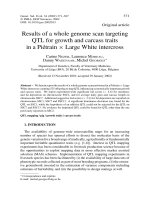

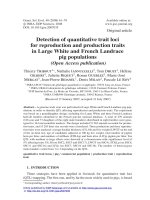
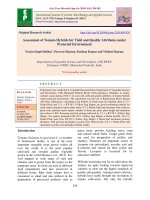
![Studies on correlation and path analysis for grain yield and quality components in foxtail millet [Setaria italica (L.) Beauv.]](https://media.store123doc.com/images/document/2020_01/09/medium_dyd1578574836.jpg)
![Combining ability studies in forage sorghum [Sorghum bicolour (L.) Moench] for yield and quality parameters](https://media.store123doc.com/images/document/2020_01/09/medium_uoj1578577680.jpg)
